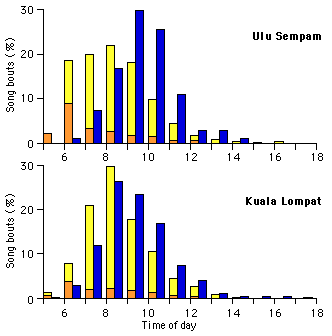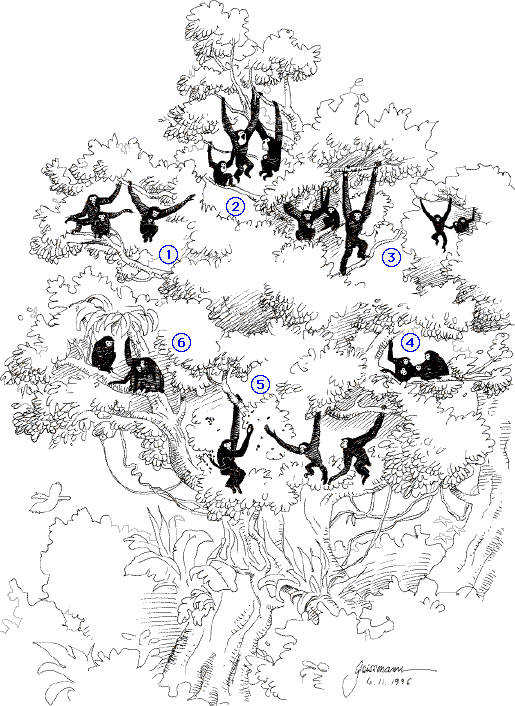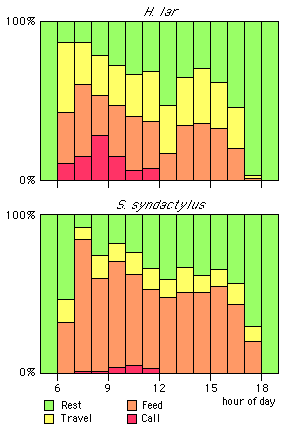Back to the Introduction index
![]() German version
German version
6. Behavioral Ecology |
Back to the Introduction index
![]() German version
German version
6. Behavioral Ecology |
Gibbons live in monogamous family groups consisting of an adult pair and 1-3 immature offspring. Pair partners usually stay together for many years. Copulations with conspecifics other than the pair partner are very rare. Adult animals of the same sex usually interact agonistically and are usually incompatible in zoos. Offspring leave the natal group upon attaining sexual maturity in order to find a pair partner and a territory. Nonreproducing adult sized offspring may, however, delay dispersal and remain in the natal group beyond the age of 10 years. Delayed dispersal may be an advantageous alternative strategy for maturing offspring in areas with high gibbon densities (Brockelman et al. 1998).
In many monogamous animal species, fathers actively participate in rearing their offspring. Young siamangs are often carried by their father during the second year of life (Chivers, 1974). This has not observed in other gibbon species.
Gibbon groups live in stable territories of about 20-40 ha. Between their feeding trees, gibbons often travel on familiar arboreal pathways (Figure 6.1). Adult gibbons defend their territories against intruders, especially against adult gibbons of the same sex. Because gibbons are strongly dependent on a particular territory, they will not migrate to another part of the forest even when heavily disturbed (Schneider, 1905). This makes them particularly vulnerable when forest is being destroyed.

Figure 6.1. Siamang (Symphalangus syndactylus): Territory (yellow) and main arboreal pathways of group RS2 in Ulu Sempam (Malayan peninsula). Areas of overlap with the territories of neighboring groups RS1 and RS4 are also indicated (after Chivers, 1974, p. 37).
Gibbons "mark" their territory with loud, long song bouts, which usually have a duration of 10 to 20 minutes, depending on species. Gibbon songs are probably derived from loud calls similar to those used by many recent members of the Hominoidea and Cercopithecoidea (Geissmann, 2000).
In most gibbon species, males and females may combine their songs to produce elaborate duet songs (Figure 6.2), during which mates coordinate their sex-specific phrases following relatively rigid rules. Only two species (Hylobates klossii and H. moloch) are not known to produce duets but segregated female song bouts and male solo song bouts only.
|
|
|
Figure 6.2. Left: Mated siamangs (S. syndactylus) produce duet songs. Siamangs have large throat sacs, which are inflated during the song. Their function is unknown, but they could serve to amplify certain frequency bands. Other gibbon species have only very small throat sacs are no throat sacs at all. Right: In some species such as the lar gibbon (H. lar), mated males not only participate in duet songs but, in addition, also produce long solo song bouts early in the morning (Photos: T. Geissmann; Taman Safari Zoo, Java, Indonesia, and Kinderzoo Rapperswil near Zurich, Switzerland).
Whereas solo song bouts probably serve a role in the defense of resources (e.g. territory,
feeding sites, partner) and possibly in mate attraction, duet song bouts may serve
additional functions. Probably, the sex-specific components differ in their functions.
In species with relatively simple duets (genera Hylobates and Nomascus,
see below), mate-guarding or pair-advertising functions are likely, whereas more
complex duets (Symphalangus, maybe Hoolock?) may also serve to strengthen
the pair bond or to advertise pair bond strength (Geissmann, 1999; Geissmann &
Orgeldinger, 2000).
Most gibbon song bouts occur in the early morning hours but calling peaks may differ among species and between sexes. The Malayan lar gibbon, for instance, has the highest calling activity around 08:00-09:00 a.m., whereas the sympatric siamang has its calling peak around two hours later (Figure 6.3).

Figure 6.3. Siamang (S. syndactylus) and lar gibbon (H. lar): Daily pattern of calling in the study sites of Ulu Sempam and Kuala Lompat (Malayian peninsula), where both species occur sympatrically. Yellow: lar duet songs; orange: lar male solo songs; blue: siamang duet songs (after Chivers, 1974, p. 254).
Gibbon species can easily be recognized by their songs (Figure 6.4). Because species-specific song characteristics are inherited, the songs have become important tools in gibbon systematics not only for species identification, but also for the reconstruction of phylogenetic relationships among the species (Geissmann, 1993, 2002a, 2002b).
Songs of all gibbon species are sexually dimorphic, albeit to varying degree. The yellow-cheeked crested gibbon (N. gabriellae), for example, produces a particularly simple duet song: Adult females typically produce just one type of song phrase, which is termed the "great call". Each great call consists of a series of ascending notes which are uttered at increasing speed; the notes and the intervals gradually become shorter during the phrase (Figure 6.4e). The phrase ends with one or several twitter like notes. More or less similar great calls also occur in the female songs of all other gibbon species. Adult males of the yellow-cheeked crested gibbon sing completely different phrases. Two types can be identified in this species: (1) series of high, rhythmical short notes (staccato-notes), and (2) series of notes with very strong frequency changes (multi-modulated notes). During a duet song bout, the male typically alternates between his two phrase types. From time to time, the female sets in with a great call. The male falls silent at the beginning of the great call and replies to it with a multi-modulated phrase known as "coda". The typical sequence of a female great call and the male coda is shown in Figure 6.4e.
Other gibbon species may use additional types of vocal interactions in their duet songs. Siamangs (S. syndactylus) produce the most complex duets known in mammals (Figure 6.4f).

Figure 6.4. Sonagrams of typical great call sequences of six gibbon species: a.) H. lar; b.) H. pileatus; c.) H. klossii; d.) H. hoolock; e.) N. gabriellae; f.) S. syndactylus. Parts which are sung by the female alone are underlined in blue, and parts which are sung by the male alone are underlined in red. Purple dashed lines indicate parts during which males and females are vocalizing at the same time.
Gibbons are specially adapted to a diet with a high proportion of ripe fruit. Trees with ripe fruit are usually widely scattered in the forest but - especially fig trees - may carry very rich aggregates of food. Leaves and insects are also eaten, but mostly as a supplement. Gibbon dietary composition may, however, exhibit strong seasonal and local fluctuations. Where siamangs and lar gibbons occur in sympatry, siamangs can more easily adopt a higher proportion of low-energy leaves in their diet. Siamangs may be more flexible because of their larger body size: A longer digestive tract is able to break down leaves more efficiently. As a result, siamangs, on average, live in smaller territories, have shorter day ranges, spend less time searching for food and spend more time eating than lar gibbons (Gittins & Raemaekers, 1980; Palombit, 1997).
This typical day in the life of a gibbon (Figure 6.5) is based on a long-term study on the siamangs of peninsular Malaysia (Chivers, 1974, 1977, p. 591).
1.
2.
3.
4.
5.
6.

Figure 6.5. A typical day in the life of a siamang family group (S. syndactylus). Numbers are explained in the text.
Other gibbon species such as the sympatric lar gibbon show many similarities in the way they spend their days. For instance, both siamangs and lar gibbons spend a large proportion of their time feeding, i.e. about 40-50% (Figure 6.6). This may be so because their food items are widely scattered, have a low energy content, or both.

Figure 6.6. Daily average activity patterns for social groups of the siamang (S. syndactylus) and the lar gibbon (H. lar) in Kuala Lompat (Malayan peninsula) (after MacKinnon & MacKinnon, 1980, p. 185).
Some differences can be recognized, as well: Whereas siamangs spend more time feeding, lar gibbons invest more time into traveling. Because lar gibbons usually eat more fruit and less leaves than siamangs, they have to travel further in order to find these fruits. Finding leaves requires less traveling, but in order to obtain the same energy amount from this diet, siamangs need to eat more.